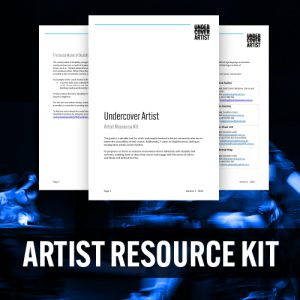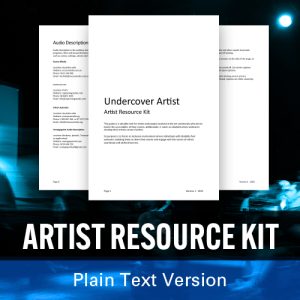The social model of disability recognises that disabling barriers are present in everyday society and are not a result of a person’s medical diagnosis. These barriers manifest in many forms, such as – limited physical access, inaccessible transport, attitudes and assumptions, and communication. When these barriers are removed, people with disability can be fully included in the community and live independently.
An example of the social model of disability in practice is:
In this context, the term ‘disability’ is used to describe these societal barriers, rather than a person’s diagnosis.
For the arts and culture sector, committing to ensuring a venue, event, or function is accessible is essential to creating equal experiences for all people.
To find out more about the social modal of disability, download The Social Model of Disability Factsheet by Inclusion London here.

This guide is a valuable tool for artists and people involved in the art community who aim to better the accessibility of their events. Additionally, it caters to disabled artists seeking to develop their artistic careers further.

This guide is a valuable tool for artists and people involved in the art community who aim to better the accessibility of their events. Additionally, it caters to disabled artists seeking to develop their artistic careers further.
Auslan is short for Australian Sign Language and is the official sign language in Australia. Auslan is used by many people who are d/Deaf or hard of hearing as a form of communication.
The following organisations can provide Auslan services at events, venues and performances:
Location: Gold Coast, Brisbane, Cairns and Townsville
Phone: 0412 388 944
Location: Australia wide
Phone: 1300 287 526
SMS: 0409 143 980
Location: Australia wide
Phone: 0423 933 361 (Voice/SMS)
Email: info@auslanstageleft.com.au
communications@auslanstageleft.com.au
Location: Banora Point, New South Wales
Phone: 07 5648 0576
Mobile: 0406 600 064
Location: Brisbane
Phone: 0429 883 385 or 0438 480 834 (SMS only)
Email: admin@strathmorewood.com.au
Location: Brisbane
Phone: 0429 883 385 or 0438 480 834 (SMS only)
Email: admin@strathmorewood.com.au
Location: Australia wide
Phone: 1300 773 803 or 0476 857 251 (SMS only)
FaceTime: 0407 647 591
Access Avenue provide one-to-one or small group Auslan education and face-to-face Auslan tutoring in Southeast Queensland. Online tutoring is available Australia wide.
Deaf Connect offers a range of online and face-to-face Auslan courses across two skill levels. They have beginner classes in face-to-face locations across ACT, QLD, NSW, SA and NT.
Lisa Mills Auslan offers an extensive range of online Auslan courses, with study at your own pace.
Melbourne Polytechnic offers a Certificate II in Auslan through online and face-to-face courses in Melbourne.
Strathmore Wood provided one-to-one tutoring in Auslan, both face-to-face and visual/online learning methods such as Zoom.
Sign Language Australia provides face-to-face Auslan classes in Adelaide.
Classes run for two hours a week, over a five-week period.
Audio description is the auditory narration of visual representations such as television programs, films and live performances. During gaps in dialogue, it describes visual elements such as scenes, settings, actions and costumes.
Location: Brisbane, Ipswich, Toowoomba, Sunshine Coast & Gold Coast (available interstate on application)
Phone: 0414 646 224
Email: vantagepointad@gmail.com
An online introductory course in Audio Description over a four week period.
An e-book and audiobook on Audio Description.
Captioning is the text version of speech, non-speech audio and other sounds to provide content and information to people who are d/Deaf or hard of hearing.
In live performances, captions can be displayed on stage screens, to the side of the stage, or through people’s handheld devices.
Open captions are embedded in the video and cannot be turned off. On-screen captions above the stage or to the side of the stage are considered open captions.
Closed captions are uploaded as a separate track to a video hosting service and are displayed when the viewer turns on closed captioning. Closed captions are often viewed by a person on a manually controlled device.
This website has detailed information on how captioning works and how to incorporate caption into a performance.
A relaxed performance is a performance that has been adapted in ways that make it more accessible for a range of sensory and communication requirements.
It is common for usual theatre practices to be removed, encouraging audience members to be themselves without judgment or restrictions. The aim is to welcome differences, in body, mind and cultural practice on and off the stage.
Relaxed performances should not be reserved for children’s shows. Please consider notifying patrons about the relaxed performance before the showing.
A Breakout or Chillout Space is a space or room designed to reduce sensory stimulation, such as loud noises, rapid movement, and intense visual effects. It allows patrons to take a break from the main action of the theatre.
Social Stories are short descriptions that explain the experience a patron might expect. They often include images and simple language. These stories can assist to reduce the stress or anxiety of attending an event and help people understand what will happen before they enter.
A Visual Story is a preshow note for people who are blind and low vision. The Visual Story helps to communicate and create an understanding of the show’s visual elements, including the set, costumes, lighting, and characters.
A Touch Tour is sometimes called a Tactile Tour. It is a preshow tour of the stage, set, props and costumes. These tours allow people to understand how the stage is set by touching and feeling props or costumes.
Location: Queensland
Specialty: Dance, Theatre, Music
Phone: 07 3505 0311
Email: info@accessarts.org.au
Location: Mackay
Specialty: Theatre, Dance, Short Films, Wearable Art, Radio
Email: admin@crossroadarts.com.au
Phone: 07 4953 5122
Location: Brisbane
Specialty: Drama, Musical Theatre
Email: info@indelabilityarts.com
Phone: 07 3342 0600
Location: Brisbane, Ipswich, Logan, Sunshine Coast
Specialty: Dance, Drama, Drumming
Email: dance@insideoutsidedance.com
Phone: 0428 156 688
Location: Brisbane, Ipswich, Logan, Sunshine Coast
Specialty: Dance, Drama, Drumming
Email: dance@insideoutsidedance.com
Phone: 0428 156 688
Location: Brisbane, Maryborough, Sunshine Coast
Specialty: Drama, Dance
Email: screecharts@cpl.org.au
Phone: 1800 275 753
Location: Brisbane
Specialty: Singing, Percussion, Dance, Drama
Phone: 1300 207 162
Location: Brisbane, Bald Hills
Specialty: Singing
Phone: 07 3510 2700
Location: Brisbane
Specialty: Singing, Song Writing, Creative Writing
A catalogue of courses about access and disability awareness training in the arts sector. And a collection of documents and checklists to help make an event more accessible.
A large document outlining the importance of accessibility, including tips on implementing accessible practices and links to other valuable resources.
A New Zealand arts organisation that has created an exhaustive list of resources to make your performance accessible.
An award is a legal document that outlines the minimum pay rates and conditions of employment. The performing arts follow the Live Performance Award.
An award is a legal document that outlines the minimum pay rates and conditions of employment. The performing arts follow the Live Performance Award.
Canva is a free online graphic design website that can help design social media and advertising resources.
Creative Plus Business offers a myriad of resources to help grow business skills.
ASPAH offers educational resources aimed at helping performers manage and maintain their health.
A website with popular topics in the Australian arts industry, including grants and opportunities.
A practical manual for artists who would like to begin or deepen their artistic practice to include work in and with the community.
A practical manual for artists who would like to begin or deepen their artistic practice to include work in and with the community.
Schedule posts, tweets, and pins for the week in one session using this handy tool. The basic version is free.
With COVID-19, self-taping as a way of auditioning has become very common. Here is a website to help.
Actors, circus performers, musicians, dancers and other live performers may have performers’ rights in their performances.
This document outlines what can and can’t be claimed at tax time.
A toolkit to help avoid mistakes and stresses involved with running a creative practice, and to offer insights into all aspects of what it means to manage and grow a creative career.
A toolkit to help avoid mistakes and stresses involved with running a creative practice, and to offer insights into all aspects of what it means to manage and grow a creative career.
Undercover Artist acknowledges the Traditional Custodians of country throughout Australia and we pay our respects to Elders, past, present, and emerging. We are committed to honouring Aboriginal and Torres Strait Islander peoples and their unique cultural and spiritual relationship to land, water and seas and their rich contribution to society.
Aboriginal and Torres Strait Islander people should be aware that this website may contain images, voices and names of deceased persons.
Festival Sponsors
This program is proudly sponsored by Brisbane City Council and the Queensland Government through Arts Queensland, with funding support from the Gambling Community Benefit Fund. This project has been assisted by the Australian Government through Creative Australia, its principal arts investment and advisory body.
Undercover Artist Festival is presented by Access Arts.